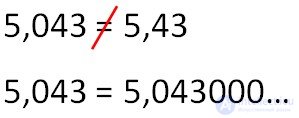Lecture
First of all we will discuss the form of decimal fraction. Each digit after the decimal point has its own name.
Tenth, hundredth, thousandth, ten thousandth ...

Let's try to read the decimal fraction from the example above. To correctly read the decimal you need:
Read the number to the left of the comma and add the word "whole", since to the left of the comma there is an integer part of the decimal fraction. We read: "forty three wholes".
Then read the number to the right of the comma: "seven thousand five hundred sixty-nine."
Add at the end the name of the rightmost digit.
We have 9, which stands at the place of ten thousandths (see figure above): “ten thousandths”.
Hence, the full name of the fraction sounds like this:
43.7569 - forty-three point seven thousand five hundred sixty-nine ten thousandths.
You can add as many zeros to the right of the comma after the most recent right nonzero digit. From this the value of the decimal fraction does not change.

In the same way, if we drop zero at the end of the decimal fraction, we will get the same decimal value.
Therefore, if during the calculations we got a decimal fraction (20,40), discard the zero at the end and write down:

Zeroes can be added (removed) only after the most recent right non-zero digit. Zeroes between digits in the number can not be removed.

Comments
To leave a comment
Arithmetic
Terms: Arithmetic